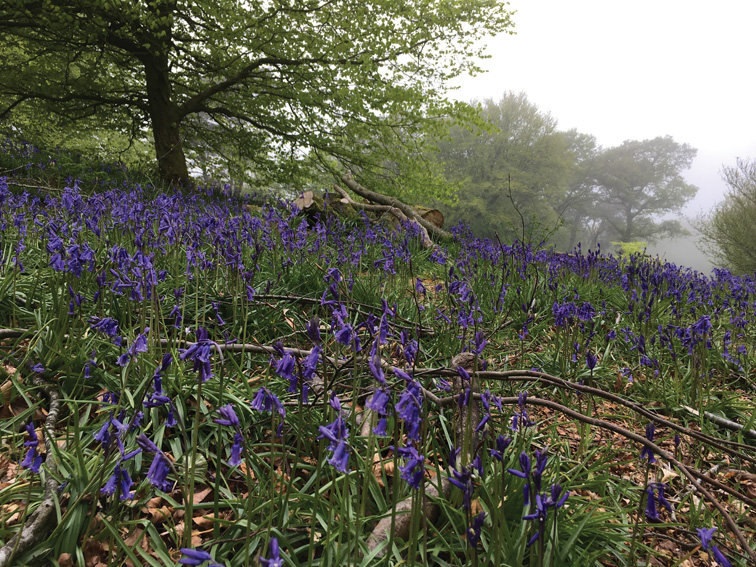A new project aimed at protecting Dorset’s historic hillforts has been unveiled by The National Trust. Margery Hookings finds out more.
I’m lucky enough to live not far from the lower slopes of Lewesdon Hill in the west of Dorset.
At 279 metres, it’s the highest point in Dorset. From the top, in between the gaps in the trees, you can look out across the lush Marshwood Vale to the sea beyond. On the western side, you have Lewesdon’s neighbour, Pilsdon, its flat-top so distinctive on the horizon. To the north and west, there is the village of Broadwindsor, the ancient Roman hillfort Waddon Hill (which is privately owned), the ridge at Rampisham and beyond.
I visit Lewesdon frequently with the dog. Getting there pretty early, I often don’t see a soul, which is how I like it. But this time of year, in April and May, the hill becomes a magnet for people drawn to Lewesdon’s carpets of bluebells. I’m not giving away any secrets by saying it’s one of the best spots to immerse yourself in this wonderful annual spectacle.
Lewesdon is one of 13 Iron Age hillforts in Dorset and Wiltshire owned by the National Trust. It is part of the major Wessex Hillforts and Habitats project which is helping to restore a healthy beautiful natural environment rich in archaeology.
Ruth Worsley, volunteering and community involvement officer, explains: ‘Currently, many of them are in poor condition with four on Historic England’s Heritage at Risk register. Many have suffered from erosion and damage from both human footfall and livestock, whilst some are heavily choked in scrub.
‘The project is recruiting volunteers to survey their condition. Resulting surveys will inform future management. It’s an inspiring project connecting communities and volunteers with heritage and nature. The project is also working to improve access and interpretation including making available a downloadable visitors guide.
‘There is a chance to get involved through Friends of the Hillforts. Alongside volunteers carrying out surveys, we would like to encourage members of the communities local to the hillforts to take on an ambassadorial role for these magical sites. Being eyes and ears and sharing their local knowledge with visitors.’
Rich in archaeology, hillforts allow us to step back in time and re-imagine the lives and livelihoods of our ancestors. Many were built in the Iron Age, more than 2,000 years ago, and all are significant landmarks. It’s easy to understand why our ancestors chose these places to live and defend themselves. They often stand in prominent isolation in the landscape so you can get a sense of their positional power whilst enjoying panoramic views across the countryside.
‘They’re as alike as Lewesdon Hill and Pilsdon Pen’ is an old Dorset saying, meaning they’re not very alike at all. Lewesdon Hillfort, masked by ancient beech and oak, contrasts with the open heather and gorse lined ramparts on the hilltop of its near neighbour, Pilsdon Pen. Along with other nearby hillforts of Coney’s Castle and Lambert’s Castle, these impressive and commanding sites line one side of the Marshwood Vale and look out to Eggardon hillfort over on the eastern side of the vale.
‘Dorset’s hillforts also give visitors extraordinary opportunities to experience nature throughout the seasons,’ Ruth says. ‘These Iron Age hillforts are of national importance not just for their archaeology, but for their diverse fragile wildlife habitats including chalk grassland, veteran trees, ancient hedgerow, and acid heathland and support some of the UK’s threatened butterflies including the Adonis Blue, and the Marsh Fritillary.’
It is thought that there was some kind of settlement on Lewesdon Hill in the Iron Age, possibly a place of refuge for people in times of threat. The site was protected from invaders by the steep natural slope on one side, and a man-made ditch and rampart on the flatter side of the hill.
It’s a mysterious and magical place with steep, ancient earthern boundaries lined with magnificent veteran beech and oak trees. It’s alive with birdsong. You can enjoy woodland birds such as green and great spotted woodpeckers, nuthatch and treecreeper. Tread quietly and you could be rewarded with a glimpse of roe deer at dusk. The woodland floor in autumn is a feast of fungi with fallen decaying trees also providing excellent habitat for beetles.
A new guide, produced by the National Trust and available to download, introduces you to the Iron Age hillforts of Dorset: nationaltrust.org.uk/hambledon-hill/features/dorsets-hillforts-a-visitors-guide
For more information on volunteering or any aspect of the project, contact Ruth Worsley on Ruth.Worsley@nationaltrust.org.uk.








